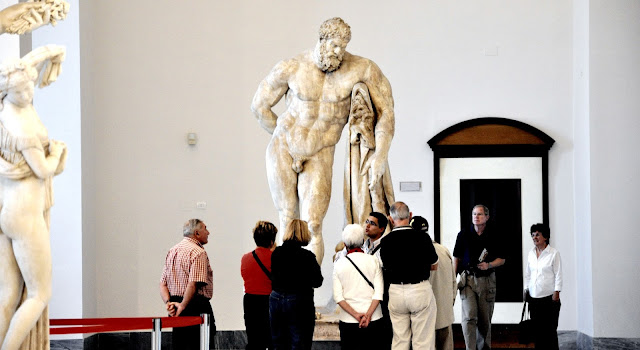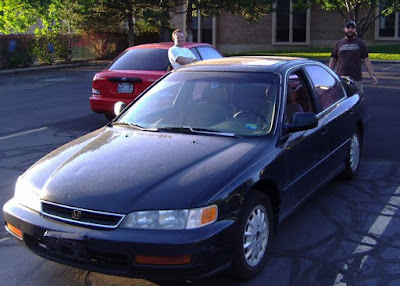Glykon's Farnese Herakles (Hercules)
Glykon's Farnese Herakles is a colossal sculpture replica of Hercules, made by Glykon, based on the original version by Lysippos. Glykon’s giant replica was discovered in 1546 on the Baths of Caracalla, in Rome. It now rests in the Museo Archeologico Nazionale in Naples.

Hercules
Herakles, known by the Romans as Hercules, was the illegitimate son of Zeus, the god of sky and thunder and the ruler, and a mortal named Alcmene. At the time, Zeus was married to his sister, Hera, goddess of women and marriage.
 When Hera found out about Zeus’ adultery, she started a series of hateful trickery towards Hercules. One of which drove Hercules to murder his wife and his two sons. As punishment for Hercules’ heinous doing, the Oracle of Delphi, in cahoots with Hera, sent him to the servitude of King Eurystheus.
When Hera found out about Zeus’ adultery, she started a series of hateful trickery towards Hercules. One of which drove Hercules to murder his wife and his two sons. As punishment for Hercules’ heinous doing, the Oracle of Delphi, in cahoots with Hera, sent him to the servitude of King Eurystheus.
The king, also in cahoots with Hera, sent Hercules to complete twelve seemingly impossible challenges, known as the labors of Hercules. The eleventh of these challenges consisted in getting Hera’s wedding gift to Zeus– The three golden Apples of the Hesperides. After going trough a tremendous ordeal to get them, Hercules decided to return the golden apples where it belonged.
Observing Glykon's Farnese Herakles, what one first notice is Hercules’ slyly exaggerated musculature. His reversed contrapposto pose has him resting, standing with most of his weight on his club. Hanging on this club is the Nemean Lion’s skin, the first of Hercules labors.
Contrapposto
After reading Hercules’ story, we can assume that this exaggeration on Hercules’ massive muscles was a symbol of strength. However, Hercules resting on the club seems to be inferring tiredness. This pose contrasts to the classical contrapposto where the human figure would stand with most of its weight on one foot giving the figure a more balanced and harmonious appearance. Greek sculptors explored the whole range of human experience in the Hellenistic period.
This is relevant because in the classic period, balanced and harmonious pose suggests what is known in Greek Philosophy as the Platonic virtue of temperament. Greek philosopher, Plato, developed the theory of the Tripartite Soul.
It consisted in the idea that all humans are made of three parts or functions: the rational part (which corresponds to the mind or soul), the “spirited” part, as he called it (which corresponds to the emotions), and the appetitive part (which corresponds to our basic primal desires such as eating, drinking, sex, etc.)
Tripartite Soul
The theory of the Tripartite Soul includes the rule that the rational part should control the spirited part, and both should work together to control the appetitive. This would bring the human soul to the virtue of Temperance– harmony and order (self –control). Glykon’s Hercules does not look balanced and harmonious. In fact, he looks exhausted and pensive.
Hercules’ massively muscular arms also seemed to try to tell us that there is a sort of conflict here. While his left arm is resting on the club, his right arm hides behind his torso, obligating the observer to go around and discover that he is holding the golden apples of the Hesperides with his right hand.
Also, one other observation on Glykon's Farnese Herakles that denotes an intentional step away from “balanced and harmonious” is Hercules’ head; it looks small compared with his bulky body.
So here we have a sculpture of one of the most notorious heroes of Greek mythology, a symbol of strength and heroism, having a conflict with exhaustion or concern, a symbol of weakness. Hercules had in deed a conflict with the three functions of the soul, and it was symbolized on Glykon's Farnese Herakles.
The rational part wanted him to finish this tremendous ordeal by completing the task given to him as punishment for his horrendous doing. Featuring Hercules’ tremendous musculature, the hanging lion’s skin, and the club insinuates that Hercules was willing to complete what he was asked. The spirited part make it so that, though he had completed the task that was asked of him, he could not allow himself to give away Zeus’ golden apples.
This conflict between the rational and the spiritual function inflicted tiredness on Hercules’ massive strong body that forced him to rest on his club.

The Baths of Caracalla were Roman public baths, built in Rome between AD 212 and 217. The baths were originally ornamented with high quality sculptures beside the Glykon’s Farnese Herakles, for example the Farnese Bull and the statue of Asclepius. There were many replicas of Lysippos’ Hercules, but Glykon's Farnese Herakles is the largest one to survived. Obviously, Hercules was a big part of Greek mythology and understanding his story helps us to understand this sculpture a little better.
Hercules
Herakles, known by the Romans as Hercules, was the illegitimate son of Zeus, the god of sky and thunder and the ruler, and a mortal named Alcmene. At the time, Zeus was married to his sister, Hera, goddess of women and marriage.
 When Hera found out about Zeus’ adultery, she started a series of hateful trickery towards Hercules. One of which drove Hercules to murder his wife and his two sons. As punishment for Hercules’ heinous doing, the Oracle of Delphi, in cahoots with Hera, sent him to the servitude of King Eurystheus.
When Hera found out about Zeus’ adultery, she started a series of hateful trickery towards Hercules. One of which drove Hercules to murder his wife and his two sons. As punishment for Hercules’ heinous doing, the Oracle of Delphi, in cahoots with Hera, sent him to the servitude of King Eurystheus.The king, also in cahoots with Hera, sent Hercules to complete twelve seemingly impossible challenges, known as the labors of Hercules. The eleventh of these challenges consisted in getting Hera’s wedding gift to Zeus– The three golden Apples of the Hesperides. After going trough a tremendous ordeal to get them, Hercules decided to return the golden apples where it belonged.
Observing Glykon's Farnese Herakles, what one first notice is Hercules’ slyly exaggerated musculature. His reversed contrapposto pose has him resting, standing with most of his weight on his club. Hanging on this club is the Nemean Lion’s skin, the first of Hercules labors.
Contrapposto
After reading Hercules’ story, we can assume that this exaggeration on Hercules’ massive muscles was a symbol of strength. However, Hercules resting on the club seems to be inferring tiredness. This pose contrasts to the classical contrapposto where the human figure would stand with most of its weight on one foot giving the figure a more balanced and harmonious appearance. Greek sculptors explored the whole range of human experience in the Hellenistic period.
This is relevant because in the classic period, balanced and harmonious pose suggests what is known in Greek Philosophy as the Platonic virtue of temperament. Greek philosopher, Plato, developed the theory of the Tripartite Soul.
It consisted in the idea that all humans are made of three parts or functions: the rational part (which corresponds to the mind or soul), the “spirited” part, as he called it (which corresponds to the emotions), and the appetitive part (which corresponds to our basic primal desires such as eating, drinking, sex, etc.)
Tripartite Soul
The theory of the Tripartite Soul includes the rule that the rational part should control the spirited part, and both should work together to control the appetitive. This would bring the human soul to the virtue of Temperance– harmony and order (self –control). Glykon’s Hercules does not look balanced and harmonious. In fact, he looks exhausted and pensive.
Hercules’ massively muscular arms also seemed to try to tell us that there is a sort of conflict here. While his left arm is resting on the club, his right arm hides behind his torso, obligating the observer to go around and discover that he is holding the golden apples of the Hesperides with his right hand.
Also, one other observation on Glykon's Farnese Herakles that denotes an intentional step away from “balanced and harmonious” is Hercules’ head; it looks small compared with his bulky body.
So here we have a sculpture of one of the most notorious heroes of Greek mythology, a symbol of strength and heroism, having a conflict with exhaustion or concern, a symbol of weakness. Hercules had in deed a conflict with the three functions of the soul, and it was symbolized on Glykon's Farnese Herakles.
The rational part wanted him to finish this tremendous ordeal by completing the task given to him as punishment for his horrendous doing. Featuring Hercules’ tremendous musculature, the hanging lion’s skin, and the club insinuates that Hercules was willing to complete what he was asked. The spirited part make it so that, though he had completed the task that was asked of him, he could not allow himself to give away Zeus’ golden apples.
This conflict between the rational and the spiritual function inflicted tiredness on Hercules’ massive strong body that forced him to rest on his club.



